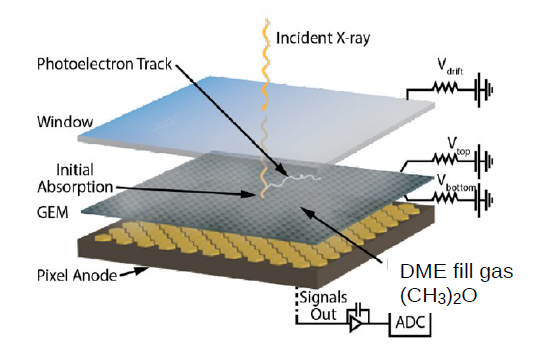


In order to characterize the performance of GPDs at low photon energies (<3 keV), the influence of X-ray absorbing materials, such as thin entrance windows, becomes significant.
To minimize this absorption and improve sensitivity during calibration, researchers often opt for a windowless setup.
This is typically implemented as follows:
The gas cell is directly exposed to monochromatic X-ray beams.
The usual entrance window is removed.
The sensor is operated in cleanroom conditions to avoid contamination of the bare readout ASIC.
This approach greatly improves the detector response at low energies, enabling more accurate calibration and polarization measurements.
This principle is equally relevant for optical and UV spectroscopy systems using CMOS/CCD sensors, where removing the protective cover glass can maximize quantum efficiency in the short-wavelength regime (e.g. 200–350 nm).
Gas Pixel Detectors (GPDs) are advanced imaging sensors used primarily in the field of X-ray astronomy, with a strong focus on X-ray polarimetry. Their working principle is based on the photoelectric effect: when an incoming X-ray photon interacts with the gas inside the detector, it ejects a photoelectron. This photoelectron ionizes the gas, creating a trail of secondary electrons that can be imaged by a high-resolution ASIC readout chip.

GPDs provide simultaneous measurement of:
Photon energy
Time of arrival
Interaction position
Direction of the photoelectron emission, which carries the polarisation signature of the incoming X-ray.
This makes GPDs unique tools for understanding high-energy astrophysical phenomena like black holes, neutron stars, and active galactic nuclei.
For more technical details, see the review:
Soffitta et al., 2021 – Polarimetry with gas pixel detectors: a breakthrough in X-ray astronomy
The group around Paolo Soffitta and Paolo Maldera, primarily based at the Istituto Nazionale di Astrofisica (INAF) in Rome and INFN Torino, has played a pioneering role in the development and application of GPDs for X-ray astronomy. Their work laid the foundation for key polarimetry missions such as IXPE (Imaging X-ray Polarimetry Explorer), launched by NASA and ASI.
Some of their key achievements include:
Development of the first operational GPDs.
Demonstration of polarization detection in the lab and in orbit.
Ongoing contribution to the calibration and deployment of space-based X-ray polarimeters
For closer details please visit:
INAF – Astrophysics and Planetary Science Department
INFN Torino – Sensor and ASIC R&D
Hier können Sie unkompliziert eine Frage oder Anfrage zu unseren Produkten stellen:
